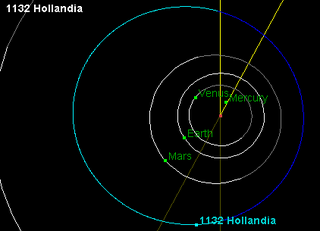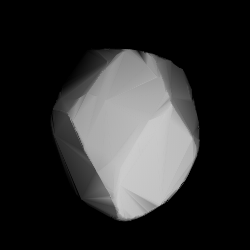4349 Tibúrcio, provisional designation 1989 LX, is a dark asteroid from the central region of the asteroid belt, approximately 29 kilometers in diameter. It was discovered on 5 June 1989, by German astronomer Werner Landgraf at ESO's La Silla Observatory in northern Chile.

1743 Schmidt, provisional designation 4109 P-L, is a dark background asteroid from the inner regions of the asteroid belt, approximately 19 kilometers in diameter. It was discovered during the Palomar–Leiden survey on 24 September 1960, by astronomers Ingrid and Cornelis van Houten at Leiden, on photographic plates taken by Tom Gehrels at Palomar Observatory in California. The C-type asteroid has a rotation period of 17.5 hours. It was named for the optician Bernhard Schmidt.

1840 Hus is a stony Koronis asteroid from the outer regions of the asteroid belt, approximately 12.5 kilometers in diameter. It was discovered on 26 October 1971, by Czech astronomer Luboš Kohoutek at the Bergedorf Observatory in Hamburg, Germany. The S-type asteroid has a rotation period of 4.8 hours and is likely elongated in shape. It was later named after 15th-century theologian Jan Hus.
Pawlowia, provisional designation 1923 OX, is a background asteroid from the central regions of the asteroid belt, approximately 20 kilometers in diameter. It was discovered on 5 October 1923, by Soviet astronomer Vladimir Albitsky at the Simeiz Observatory on the Crimean peninsula. The asteroid was named after Russian physiologist and Nobelist Ivan Pavlov.
1024 Hale, provisional designation A923 YO13, is a carbonaceous background asteroid from the outer regions of the asteroid belt, approximately 45 kilometers (28 miles) in diameter. The asteroid was discovered on 2 December 1923, by Belgian–American astronomer George Van Biesbroeck at the Yerkes Observatory in Wisconsin, United States. It was named for American astronomer George Ellery Hale. The dark C-type asteroid may have a rotation period of 16 hours.

1118 Hanskya is a large background asteroid, approximately 77 kilometers in diameter, located in the outer regions of the asteroid belt. Discovered by Sergey Belyavsky and Nikolaj Ivanov in 1927, it was named after Russian astronomer Aleksey Hansky. The presumed dark C-type asteroid has a rotation period of 15.6 hours.

1132 Hollandia, provisional designation 1929 RB1, is a stony asteroid from the middle region of the asteroid belt, approximately 27 kilometers in diameter. It was discovered on 13 September 1929, by Dutch astronomer Hendrik van Gent at Leiden Southern Station, annex to the Johannesburg Observatory in South Africa. It was named for the region Holland in the Netherlands.
(9928) 1981 WE9, provisional designation 1981 WE9, is a stony Florian asteroid from the inner regions of the asteroid belt, approximately 3 kilometers in diameter. It was discovered on 16 November 1981, by astronomers at Perth Observatory in Bickley, Australia.

1551 Argelander, provisional designation 1938 DC1, is a background asteroid from the inner regions of the asteroid belt, approximately 10 kilometers (6.2 miles) in diameter. It was discovered on 24 February 1938, by Finnish astronomer Yrjö Väisälä at the Turku Observatory in southwest Finland. The likely S-type asteroid has a rotation period of 4.1 hours. It was named after German astronomer Friedrich Argelander.
11277 Ballard (provisional designation 1988 TW2) is a Phocaea asteroid from the inner regions of the asteroid belt, approximately 6.3 kilometers (3.9 miles) in diameter. It was discovered on 8 October 1988, by American astronomer couple Carolyn and Eugene Shoemaker at the Palomar Observatory in California. The assumed S-type asteroid has a rotation period of at least 10 hours. It was named for American marine scientist Robert Ballard.

1281 Jeanne is a dark asteroid from the background population of the intermediate asteroid belt. It was discovered on 25 August 1933, by astronomer Sylvain Arend at the Royal Observatory of Belgium in Uccle, who named it after his daughter, Jeanne. The likely P-type asteroid has a rotation period of 15.2 hours and measures approximately 22 kilometers in diameter.
1303 Luthera, provisional designation 1928 FP, is a dark asteroid and the parent body of the Luthera family, located in the outermost regions of the asteroid belt. It measures approximately 90 kilometers in diameter. The asteroid was discovered on 16 March 1928, by astronomer Friedrich Schwassmann at the Bergedorf Observatory in Hamburg, Germany, and later named after German astronomer Robert Luther.

1332 Marconia, provisional designation 1934 AA, is a dark asteroid and the parent body of the Marconia family located in the outer regions of the asteroid belt. It measures approximately 46 kilometers in diameter. The asteroid was discovered on 9 January 1934, by Italian astronomer Luigi Volta at the Observatory of Turin in Pino Torinese, northern Italy. It was named for Italian electrical engineer Guglielmo Marconi. The uncommon L-type asteroid has a rotation period of 19.2 hours.
1455 Mitchella, provisional designation 1937 LF, is a Florian asteroid, slow rotator and suspected tumbler from the inner regions of the asteroid belt, approximately 7 kilometers in diameter. It was discovered on 5 June 1937, by astronomer Alfred Bohrmann at the Heidelberg-Königstuhl State Observatory in southwest Germany. The asteroid was named after American astronomer Maria Mitchell.
2043 Ortutay, provisional designation 1936 TH, is a dark asteroid from the outer regions of the asteroid belt, approximately 45 kilometers in diameter. The asteroid was discovered by Hungarian astronomer György Kulin at the Konkoly Observatory, Budapest, on 12 November 1936. It was named after Hungarian ethnographer Gyula Ortutay.

1648 Shajna, provisional designation 1935 RF, is a stony asteroid from the inner regions of the asteroid belt, approximately 9 kilometers in diameter. It was discovered on 5 September 1935, by Russian astronomer Pelageya Shajn at Simeiz Observatory on the Crimean peninsula. Two weeks later, it was independently discovered by Cyril Jackson at Johannesburg Observatory, South Africa. It was later named after the discoverer and her husband, Russian astronomers Grigory Shajn.
1405 Sibelius, provisional designation 1936 RE, is a stony Florian asteroid from the inner regions of the asteroid belt, approximately 8 kilometers in diameter. It was discovered on 12 September 1936, by Finnish astronomer Yrjö Väisälä at Turku Observatory in Southwest Finland. The asteroid was named after composer Jean Sibelius.

1493 Sigrid, provisional designation 1938 QB, is a dark Nysian asteroid from the inner regions of the asteroid belt, approximately 24 kilometers in diameter. It was discovered on 26 August 1938, by Belgian astronomer Eugène Delporte at the Royal Observatory of Belgium in Uccle. It was named after Sigrid Strömgren, wife of astronomer Bengt Strömgren.
2391 Tomita, provisional designation 1957 AA, is a Nysian asteroid from the inner regions of the asteroid belt, approximately 15 kilometers in diameter. The asteroid was discovered on 9 January 1957, by German astronomer Karl Reinmuth at Heidelberg Observatory in southern Germany. It was named after Japanese astronomer Kōichirō Tomita.
3823 Yorii, provisional designation 1988 EC1, is a carbonaceous asteroid from the outer region of the asteroid belt, approximately 11 kilometers in diameter.









